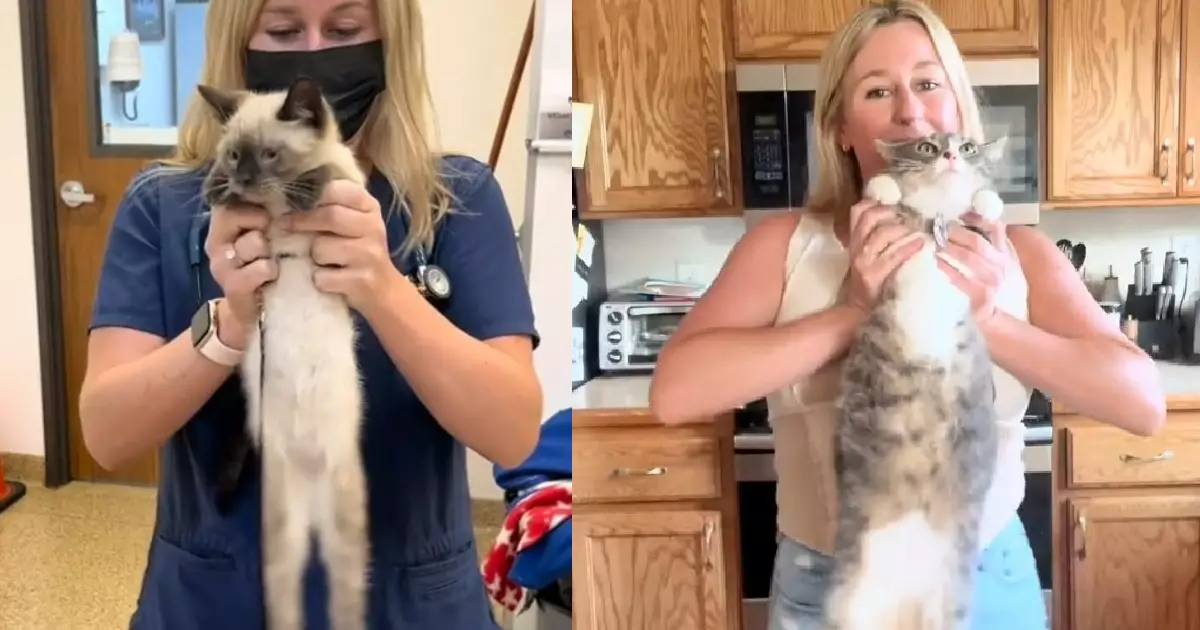In recent months, social media has become a fertile ground for quirky pet experiments, with the “dangle test” capturing the attention of millions. Originating from the humorous perspective of a Kansas veterinarian, Dr. Tori Given, the experiment involves gently suspending a kitten or puppy and observing their behavior to gauge temperament. With over 7.5 million views on TikTok and countless amusement-filled comments, the trend exemplifies how simple tests can rapidly acquire viral status among pet owners eager for quick insights. Despite its lighthearted presentation, this test taps into a primal curiosity about whether a pet’s reaction can serve as an indicator of personality traits.
What makes this trend compelling is its blend of humor and supposed practicality. Pet owners, often anxious about their animals’ future behavior, find comfort—if not outright entertainment—in the idea that a minor, seemingly harmless action could reveal their cat’s or dog’s temperament. Such viral phenomena reflect a longing for quick psychological profiles, reminiscent of the way humans seek to understand each other’s personalities through basic gestures or tests. However, beneath the surface, questions arise: Is the “dangle test” scientifically valid, or does it merely provide a snapshot of a pet’s momentary response?
Critical Reflections: A Study in Caution and Misinterpretation
While the “dangle test” appears to be a harmless and amusing activity, applying it to assess pet temperament is fraught with risk and potential misinterpretation. Cats and dogs are sensitive creatures; their reactions are heavily influenced by their individual histories, current mood, stress levels, and environmental factors. A reaction—or lack thereof—is unlikely to provide any reliable indicator of long-term personality. To assume that a pet’s willingness to tolerate being gently dangled correlates to its overall temperament borders on oversimplification.
Moreover, the anecdotal and playful tone of the veterinarian’s TikTok minimizes serious concerns about animal welfare. Dogs and cats, if stressed or scared, might still appear to remain calm in the moment but could develop anxiety or behavioral issues later. What appears as a “good” response may be as superficial as a temporary freeze rather than genuine contentment or resilience. Such assessments risk normalizing behaviors that could be harmful if practiced repeatedly or without professional guidance, inadvertently encouraging pet owners to experiment in ways that may cause discomfort or distress.
From a scientific perspective, temperament testing involves comprehensive evaluations rooted in animal psychology, behavioral analysis, and sometimes even physiological measurements. These methods are far more nuanced than a viral trend shared for entertainment. Simplistic tests like “dangle” neglect the complexity of animal personalities and offer no predictive validity beyond the moment of testing. They are better suited for laughs and social media engagement than for serious behavioral assessment.
The Power and Pitfalls of Social Media as an Educational Tool
Despite its questionable reliability, the viral spread of the “dangle test” underscores the impressive influence social media wields in shaping public perceptions of pet care. Dr. Given’s intent to connect with other veterinary professionals and share insights has been overshadowed by the trend’s popularity among pet owners eager for fun challenges. This scenario spotlights a broader issue: the balance between entertainment, education, and responsibility.
Veterinarians and pet influencers alike must navigate the fine line separating humorous engagement from misinformation. While sharing amusing tests can foster bonding and curiosity, it’s crucial to clarify their limitations and potential risks. Educational content should emphasize that interpreting animal behavior requires expertise and that misjudgments based on impulsive experiments could have ethical and emotional consequences.
Furthermore, viral trends like the “dangle test” can distort public understanding of animal behavior, leading pet owners to prioritize superficial assessments rather than investing in proper training, socialization, or behavioral consultation. It also reveals a cultural tendency to seek instant gratification — a quick test to determine if Fluffy will be “good” without considering the complexities of animal psychology.
Final Reflections: A Trend to Approach with Caution and Respect
While the “dangle test” undeniably entertains and stirs curiosity, it is vital to approach such viral phenomena with a healthy dose of skepticism. Assessing an animal’s true temperament requires care, patience, and scientific understanding—not a casual, viral challenge designed for social media likes. The real insight lies in recognizing that every pet is a unique individual. Their behaviors are shaped by a multitude of factors that cannot be distilled into one simple, viral test.
As pet owners, fostering a respectful and empathetic relationship with animals involves more than playful experiments; it demands knowledge, compassion, and, when necessary, professional guidance. Viral trends should serve as entry points for curiosity, not replacements for responsible pet care. Understanding the limitations of playful tests like the “dangle” can prevent unwarranted concerns and promote healthier interactions with our furry companions, rooted in genuine understanding rather than fleeting internet fame.

